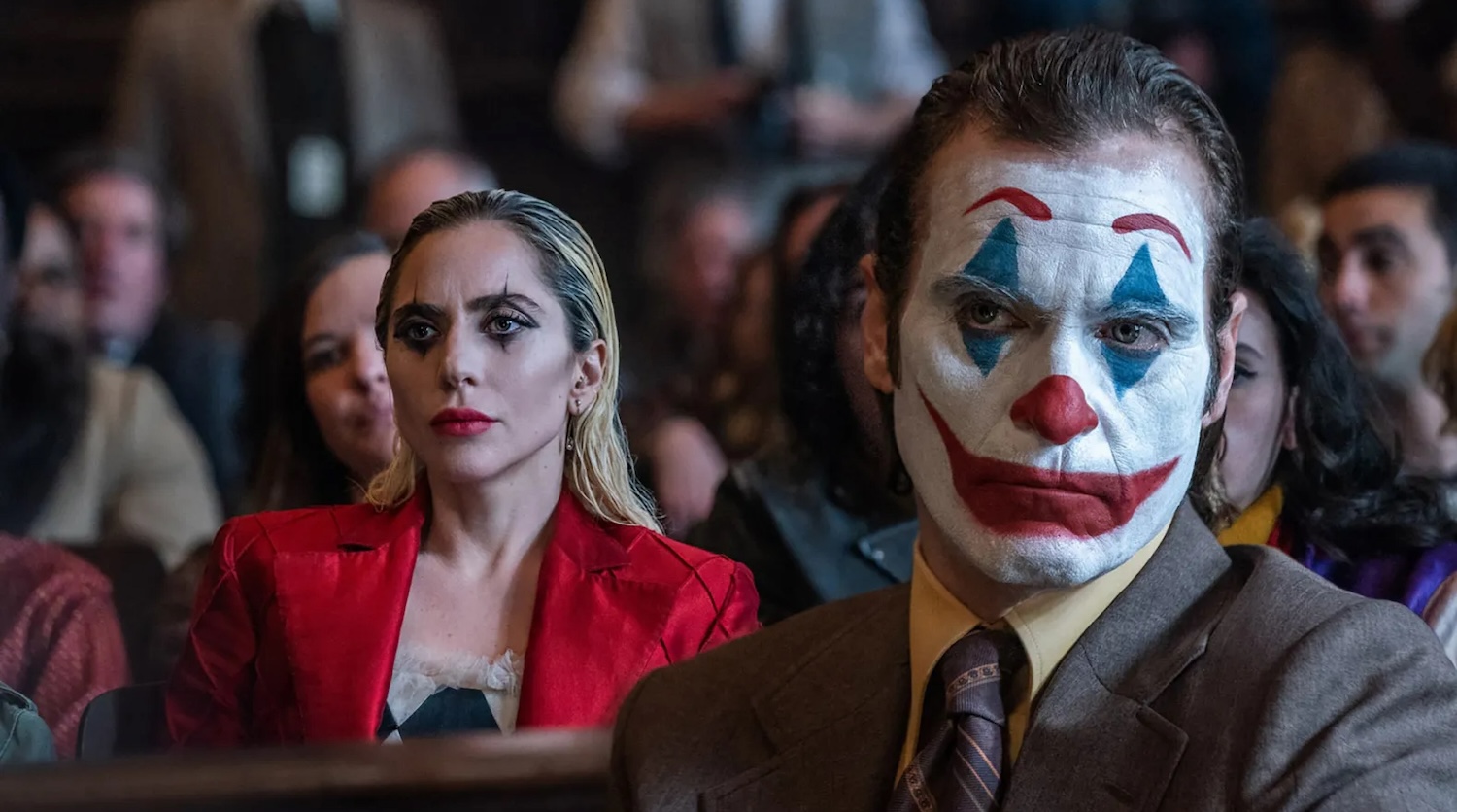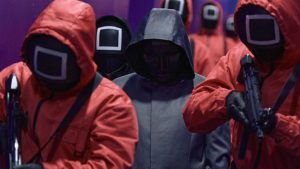
This article contains Joker: Folie à Deux spoilers.
If Arthur Fleck had a favorite song, it was probably “That’s Life,” the Dean Kay and Kelly Gordon big band standard first recorded in 1963 and popularized by Frank Sinatra in ’66. A bit of a mean-spirited lament, the song features acerbic observations like “you’re riding high in April, shot down in May,” and “but if there’s nothing shaking, come this here July, I’m gonna roll myself up in a big ball and die.”
Frankly, it’s pretty bleak if you listen to it for more than a minute, and diametrically opposed to where we first met Arthur Fleck (Joaquin Phoenix) in Todd Phillips’ Joker, a movie that begins with a sad man desperate to bring joy and happiness to others. But it was the theme song chosen by his favorite late night comedian, Murray Franklin (Robert De Niro), so that was that. At least until Arthur donned copious amounts of pancake makeup and blew ol’ Murray away on live broadcast television.
Arthur, under his new persona as Joker, made Murray live the meaning of the song, right down to a bloody tee. So by the time Joker: Folie à Deux rolled around, you might expect Arthur would still be riding high on the tune. Yet he isn’t. Despite Joker 2 being ostensibly a musical filled with sequences of Arthur imagining himself or his great love, Lee Quinzel (Lady Gaga), belting out standards of yesteryear, he never once vocally touches “That’s Life.”
But he still hears it.
In fact, it is the last thing he ever hears as he bleeds out on the shitty concrete floor of Arkham Asylum, dripping blood and viscera from the belly after getting carved up by a fellow patient in that dank mental institution. As the camera dollies in on his face, we hear the sick slather of his killer slicing up his own face too. All Arthur seems to hear though is another rendition of “That’s Life” as the curtains close on his miserable existence.
It’s a brutal ending, and one which will probably leave more than a few viewers stunned. Five years ago, we thought we were witnessing the birth of a supervillain—Batman’s arch-nemesis given a new tragic backstory reminiscent of some of Robert De Niro’s greatest antiheroes: Travis Bickle in Taxi Driver or Rupert Pupkin in The King of Comedy. Joker even climaxed with the death of Bruce Wayne’s parents, seemingly setting the boy who would be Batman on a collision course with a clown who once introduced himself to the young Gotham princeling as a brother.
Yet that is not how Arthur’s story is revealed to end in Joker 2. He never becomes the Clown Prince of Crime ruling over Gotham’s underworld; he never faces the Batman; he never even commits a crime with a perpetually unimpressed Harley Quinn (Harley Quinn), who in this story leaves his pathetic ass after he says he isn’t really the Joker. It is a scene-by-scene stripping of the comic book trappings Arthur assembled in the first movie. Some fans will likely feel insulted, but there is a point to Joker: Folie à Deux’s madness.
Joker 2 Puts Joker 1 On Trial
For better and often worse, Joker 2 becomes an extended dialogue about the reception for Joker, a movie that earned $1 billion worldwide and won three Oscars, including a little gold man for Phoenix’s interpretation of the guy in the purple suit. In spite of all that success, the film had many detractors as well as an enthusiastic embrace from various corners of the internet, including of the dark variety.
Ergo, by building Joker: Folie à Deux around Arthur Fleck’s inevitable trial following the crimes of the first film, the sequel becomes an opportunity for writer-director Todd Phillips to engage with both points-of-view on his first film and, in essence, explain why either side is wrong.
In one camp, you have a young, smug prosecutor named Harvey Dent (Harry Lawtey) and the full severity of the state. They want to literally fry Arthur in an electric chair. “He is a monster,” Dent tells reporters on the TV and radio. They view Arthur as little more than a wolf walking amongst sheep that needs to be put down. Conversely, you have the sheep, or at least the most unsettling fans: the kind who dress up like the Joker and idolize him as some kind of folk hero who gave them permission to do bad things… like, say, gun down the rich in front of little baby Bruce Wayne.
Both perspectives represent a predictable reaction to a guy who killed America’s favorite comedian on late night TV. But they also encapsulate a reaction to the previous film, which saw some critics clutching their pearls and refusing to give it a grade because Phillips’ movie was “too dangerous,” a naive and somewhat regressive way to engage with art. Then there was that group of vocal online fans who seemed to worship the movie a little too much, cosplaying as Arthur Fleck’s Joker, but also copying his mannerisms, his attitude, and thinking he had something important to say about society.
In other words, the movie appealed to both comic book fans who wanted some of their favorite characters taken seriously as highbrow art and maybe felt a little too vindicated by Arthur’s not necessarily reliable narration/perspective, as well as edgelords and alt-right media personalities who peddle in grievance for loners and toxic segments of fandom (i.e. “incels”). This in turn feeds into the narrative of Joker’s detractors. For example, David Edelstein wrote in Vulture, “It’s an anthem for incels” and seems to indicate a connection between “civil massacres” and the character of the Joker.
Both sides, Joker Folie a Deux insists, failed to understand the humanity of poor Arthur, and this becomes the entire thrust of the sequel’s exhausting 138 minutes. You have those who wish to demonize Arthur as a monster, and those who see that monster as some kind of rock star leader who needs to be unleashed again. But in Phillips and presumably Phoenix’s reading, Arthur was never that guy—not the singer of an “anthem for incels” or the idol of his age. In fact, the only person who seems to see Arthur for who he is in the sequel is his defense attorney Maryanne Stewart (Catherine Keener), who spends most of her scenes explaining the thinly veiled subtexts and themes of the first movie.
The fact that Arthur’s mother (Frances Conroy) had him give her baths while he was in his underwear in the 2019 movie strongly hinted at a tragic background in psychological and likely sexual abuse. That is made explicit in Joker 2 when Maryanne says Arthur was abused in all those ways at seven years old when the state failed to take him away from a mentally unwell mother. Arthur is a victim of his mother but also a society that fails those without power. Maryanne says this ugly truth to symbols of the system and the status quo, as well as to those in the movie’s audience who just write off the lonely and mentally ill as “incels.”
On the flip side are individuals who see Arthur killing Murray Franklin as a moment of liberation instead of a final hard turn into endless tragedy. It’s those guys who blow up the courthouse where Arthur is being sentenced, and their fellow travelers who mistake this troubled and in-need guy as some kind of hero who they hide in their car, presumably to some “safe space” where he can tell them what to do next. They literally get themselves run over while chasing after this false messiah.
The Harley Quinn of It All
These exploitative users and sycophants who have too much of a parasocial fixation on Arthur are best represented by Lady Gaga’s Lee, who is Harley Quinn in name only. In practice, she has more in common with some of Charles Manson’s followers, or “Manson Girls,” who would come to his trial in 1970 to perform worshipful stunts in the presence of the press and cameras.
This Harley is also a liar. She introduces herself early in Joker 2 as a kindred spirit whose father died in a car crash and whose mother committed her against her will. In reality, she committed herself to meet Arthur and give him a sob story that precludes the truth that she was born rich, lives on the Upper East Side, and dropped out of graduate school for psychology. Even her father is alive.
Lee has an unhealthy psychosis and fixates on Arthur, but only because she is an avatar for the worst parts of modern internet culture who saw the first movie’s Arthur Fleck as a hero. She is also the character who gets Arthur to distance himself from the only human being trying to help him and who seems to genuinely care about him, Keener’s Maryanne. He fires the defense lawyer and does what Lee wants him to, performing as the “Joker” in front of the world on television, even if it is hazardous to his health. Hell, it gets him convicted on six counts of murder in a state with the death penalty!
Arthur goes on to have fantasies that include sequences vaguely like what fans of the comic books might expect: visions of Joker and Harley somehow turning the media circus around the trial into another grisly spectacle like the Murray Franklin Show, with Joker maiming the D.A. and murdering the judge by bludgeoning him death with his own gavel. But even these delusions are provided in a way few comic book fans would want; it’s a stylized musical sequence.
In the end, such antics are divorced from reality. Once you’re in the belly of the beast, it’s over. Lee knows that too. She lies to Arthur that she’s pregnant, but she later seems to confirm it was another manipulation after he actually escapes the courthouse and finds her by “their” staircase. She hides there like many fans of the first Joker do, treating it as a tourist site for pilgrimage. But Lee doesn’t want Arthur. She wanted Joker: Folie à Deux to presumably be like the first movie—or what a fangirl might expect from a movie featuring “Joker” in the title. She expects a carnival of chaos and mayhem.
But a courtroom drama about this sad sack who admitted Joker is just an invention he concocted to cope with his loneliness? That’s pathetic, dude. She leaves him flat to be picked up by the authorities he’s already let convict him of murder in order to gain her fleeting approval.
You Get What You Deserve
So we come back to the end of the movie. All the Batman comic trappings have led to nothing: Harvey Dent is not so badly scarred as to become Two-Face, Harley Quinn exploited Joker, instead of the other way around, and abandoned him to the law when he didn’t embrace his role as the twisted master criminal; and Joker… he’s literally gutted by another fan who proves as fair-weather in his admiration as Lee.
In fact, the last line of the movie is the fan paraphrasing Arthur’s final line to Murray Franklin before blowing his brains out: “You get what you fucking deserve.”
The tragic irony of the ending is that this isn’t what Arthur deserved in Phillips’ estimation. He was a sad, mentally ill individual who needed love and support, and never found it from anyone. His mother abused him, Harley Quinn used him, and society vilified him after discarding him to despair decades ago. He could delude himself into seeing his “life as a comedy,” but in the end there’s nothing to laugh about.
It’s an intentional, full-throated abdication of what a movie titled “Joker” is supposed to be about, and essentially an admonishment of the first film’s biggest critics and fans alike. Some might wonder if the guy who killed Arthur will become the “real” Joker, but that’s not the point. The point is to think that way leads to meaningless acts of self-destruction.
Creatively there is a certain boldness in this approach. Dramatically, however, it’s unsatisfying. The film is less of a narrative than it is a diatribe with the artist in self-loathing conversation with himself. Joker: Folie à Deux seems to lament how it believes the first film was (mis)interpreted and is determined to disappoint anyone who buys a ticket in 2024 to the sequel. It wants you to feel sorry for Arthur, and guilty for not seeing him as a human. Yet its piling on of Arthur’s plight is contrived purely due to contempt for anyone it considers too callous to appreciate the first movie, or failing to appreciate it in the right way.
Joker 2 is a cry for help, but one that is hard to hear through all that self-pity.
Joker: Folie à Deux is in theaters now.
The post Joker 2 Ending Explained: Let’s Unpack That Shocker appeared first on Den of Geek.






